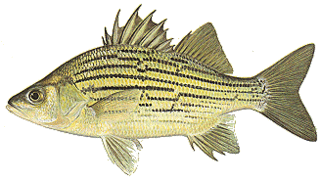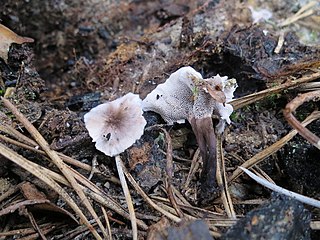
An alligator, or colloquially gator, is a large reptile in the Crocodilia order in the genus Alligator of the family Alligatoridae. The two extant species are the American alligator and the Chinese alligator. Additionally, several extinct species of alligator are known from fossil remains. Alligators first appeared during the Oligocene epoch about 37 million years ago.

The American alligator, sometimes referred to colloquially as a gator or common alligator, is a large crocodilian reptile native to the Southeastern United States and a small section of northeastern Mexico. It is one of the two extant species in the genus Alligator, and is larger than the only other living alligator species, the Chinese alligator.

The yellow bass is a member of the family Moronidae. This species is a deep bodied fish that possesses five to seven dark stripes laterally along the sides, the lowest few of these are often broken or disrupted anterior to the origin of the anal fin. This species is somewhat similar to two other species in the family Moronidae, the white bass and the striped bass. The yellow bass is distinguishable from both of these species by having the offset lateral stripes above the anal fin and from not possessing tooth patches on the tongue. The yellow bass differs further from the white bass by having nine to ten anal rays in comparison to eleven or thirteen. The back of the fish is usually a dark olive green, and the abdomen and sides are often a silvery yellow.

Hydnellum is a genus of tooth fungi in the family Bankeraceae. Widely distributed in the Northern Hemisphere, the genus contains around 40 species. The fruitbodies of its members grow by slowly enveloping nearby bits of grass and vegetation. There is great variability in the form of Hydnellum fruitbodies, which are greatly influenced by environmental conditions such as rainfall and humidity, drying winds, and temperature. They are too tough and woody to eat comfortably. Several species have become the focus of increasing conservation concern following widespread declines in abundance.

Bankera is a genus of four species of tooth fungi in the family Bankeraceae. The genus was first circumscribed in 1951 by William Chambers Coker and Alma Holland Beers, but this publication was invalid according to the rules of botanical nomenclature. It was later published validly by Zdeněk Pouzar in 1955. The type species is B. fuligineoalba. The genus is ectomycorrhizal with gymnosperms, usually with trees from the pine family.

Phellodon is a genus of tooth fungi in the family Bankeraceae. Species have small- to medium-sized fruitbodies with white spines on the underside from which spores are released. All Phellodon have a short stalk or stipe, and so the genus falls into the group known as stipitate hydnoid fungi. The tough and leathery flesh usually has a pleasant, fragrant odor, and develops a cork-like texture when dry. Neighboring fruitbodies can fuse, sometimes producing large mats of joined caps. Phellodon species produce a white spore print, while the individual spores are roughly spherical to ellipsoid in shape, with spiny surfaces.

The hydnoid fungi are a group of fungi in the Basidiomycota with basidiocarps producing spores on pendant, tooth-like or spine-like projections. They are colloquially called tooth fungi. Originally such fungi were referred to the genus Hydnum, but it is now known that not all hydnoid species are closely related.

Phellodon sinclairii is a native tooth fungus found in beech forests of New Zealand. It was first described by Miles Joseph Berkeley in 1867 as a species of Hydnum in Joseph Dalton Hooker's work Handbook of the New Zealand Flora. The type locality was on Maungatua. Gordon Herriot Cunningham transferred the species to the genus Phellodon in 1958.

Phellodon secretus is a rare species of tooth fungus in the family Bankeraceae. Described as new to science in 2003, it is found in Finland, where it grows under the fallen trunks of pine trees. It somewhat resembles Phellodon connatus, but has a thinner stipe, a softer, cotton-like cap, and smaller, rounder spores.
Phellodon radicatus is a species of tooth fungus in the family Bankeraceae. It was described as new to science in 1985 from collections made in Gainesville, Florida.
Phellodon putidus is a species of tooth fungus in the family Bankeraceae. Found in North America, it was first described scientifically by George F. Atkinson as Hydnum putidum in 1900. Howard James Banker transferred it to the genus Phellodon in 1906.
Phellodon plicatus is a species of tooth fungus in the family Bankeraceae. Found in Australia, it was first described in 1925 by Curtis Gates Lloyd as a species of Hydnum. Dutch mycologist Rudolph Arnold Maas Geesteranus transferred it to the genus Phellodon in 1966.
Phellodon tenuis is a species of tooth fungus in the family Bankeraceae. Found in Brazil, it was described as new to science in 1988 by Richard Baird.
Phellodon excentrimexicanus is a species of tooth fungus in the family Bankeraceae. Found in Mexico, it was described as new to science in 1985 by mycologist Richard Baird. It is similar in appearance to Phellodon fibulatus, which is found in the southern Appalachian Mountains, but the Mexican species lacks clamp connections, and its stipe is consistently eccentric.
Phellodon fibulatus is a species of tooth fungus in the family Bankeraceae. Found in the United States, the fungus was described as new to science in 1972 by Canadian mycologist Kenneth A. Harrison. It is one of the few species of Phellodon that possess clamp connections in its hyphae.
Phellodon implicatus is a species of tooth fungus in the family Bankeraceae. It was described as new to science in 1986 from collections made in Florida. It is one of the few Phellodon species known to possess clamp connections in its hyphae.
Phellodon maliensis is a species of tooth fungus in the family Bankeraceae. Found in Australia, it was originally described as a new species by Curtis Gates Lloyd in 1923. It was originally placed in Hydnum, until Dutch mycologist Rudolph Arnold Maas Geesteranus transferred it to the genus Phellodon in 1966.

Phellodon niger, commonly known as the black tooth, is a species of tooth fungus in the family Bankeraceae, and the type species of the genus Phellodon. It was originally described by Elias Magnus Fries in 1815 as a species of Hydnum. Petter Karsten included it as one of the original three species when he circumscribed Phellodon in 1881. The fungus is found in Europe and North America, although molecular studies suggest that the North American populations represent a similar but genetically distinct species.

Phellodon melaleucus, commonly known as the grey tooth, is a species of tooth fungus in the family Bankeraceae. It was originally described by Elias Magnus Fries in 1815 as a species of Hydnum. In 1881, Petter Karsten included it as one of the original three species in his newly circumscribed genus Phellodon. The fungus is widely distributed in Europe and North America, where it associates mycorrhizally with a wide range of host trees. It is considered vulnerable in Switzerland.
Kenneth A. Harrison was a Canadian mycologist. He was for many years a plant pathologist at what is now the Atlantic Food and Horticulture Research Centre in Nova Scotia. After retirement, he contributed to the taxonomy of the Agaricomycotina, particularly the tooth fungi of the families Hydnaceae and Bankeraceae, in which he described several new species.









